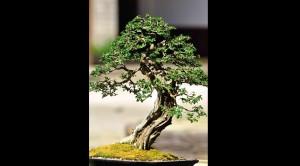
ONE of the bonsai creations on exhibit in Tayug, Pangasinan, where bonsai-making is growing big. WILLIE LOMIBAO/CONTRIBUTOR
In the northern provinces of Pangasinan and Ilocos Norte, tree lovers are going small.
In the town of Tayug, Pangasinan and Batac City in Ilocos Norte, bonsai-making is becoming a fad.
More residents, not only in Tayug but neighboring eastern Pangasinan towns, are now into bonsai-making not only because the hobby is relaxing, but also because materials for it are in abundance.
Bonsai refers to an ornamental tree or shrub that is grown in a pot with the use of special methods to control its growth.
At the weeklong bonsai exhibition in Tayug that will end on March 21, among the 60 dwarf trees displayed were lagundi, red balete, yellow doggie, gumamela, santan and bougainvillea.
“These plants are beautiful attractions in a house. As a hobby, bonsai-growing is relaxing,” said Daryl Amon, a member of the Tayug Bonsai Group.
“I’ve been doing this in the last six years and I have always enjoyed it,” he said.
Amon said to be a successful bonsai grower, one must have an eye for art. This is important, he said, so that a material will be groomed to an aesthetically appealing form.
“If you have an eye for art, you would immediately have an idea how a material can be developed into a beautiful bonsai the moment you see it,” he said.
Bonsai-making course
In Batac City, the country’s first school on bonsai-making opened at the Mariano Marcos State University (MMSU).
At least 30 students compose the first batch that would be trained as bonsai technicians. The hands-on course runs for about six months.
Dr. Miriam Pascua, MMSU president and a plant biology expert, said knowing the art of bonsai-making is simply not enough so “we need a school to cater to the global demand for bonsai technicians, particularly in Asia, Europe and the United States.”
“It’s not just knowing the art, we should teach them the science of bonsai-making such as physiology, anatomy and morphology of these species as each is different from the other and needs a specific treatment,” Pascua said.
“For now, we have our horticulture students to compose the first batch. This will also be open to out-of-school youth or anybody who is a plant lover,” she said.
She cited the need for continuous research and development so local bonsai-making would keep up with the global market.
Augusto Bautista, head of the Department of Environment and Natural Resources’ (DENR) protected area, wildlife and coastal zone management unit in Alaminos City, said gathering of bonsai materials from protected areas is prohibited, unless the activity is sanctioned by the agency.
“We have no problem with locally grown materials, such as guava, santan and other readily available ornamental and fruit trees,” he said.
Amon, a Tayug Bonsai Group member, said growing bonsai into a desired form involves patience and skill.
“This is why we always advise those who are interested in bonsai-growing to undergo first a series of seminars,” he said. He admitted that the hobby is expensive because of the cost of materials.
Bonsai-making, however, could be profitable, he said.
Amon said a bonsai fetches a minimum price of P2,000 each. The more expensive ones can cost up to P100,000 each.
MMSU president Pascua said the bonsai school’s operation is supported by the Philippine Bonsai Society, the Ilocos Norte Bonsai Society, the Ilocos Norte provincial government and the DENR.
The MMSU’s bonsai school, through its partnership with Ilocos Norte Bonsai Society, will also keep and nurture endangered plant species, including bonsai planting materials seized by police. Gabriel Cardinoza and Leilani Adriano, Inquirer Northern Luzon